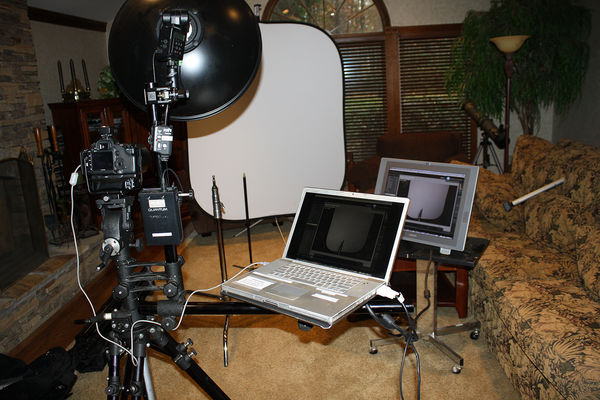Why are tripods so expensive.
Apr 5, 2018 10:55:42 #
Ron Dial
Loc: Cuenca, Ecuador
Try a Bogen Carbon Fiber Tripod. Very light, very strong and worth the money.
Apr 5, 2018 10:57:43 #
Photographer Jim wrote:
The assumption here is that the only differences b... (show quote)
Jim, clearly there are a lot of "experts" here. When their tripods fail, or when they try to get to be steady for macro or long lens use and they wonder why their shots aren't sharp. . . you know how it goes.
Apr 5, 2018 11:04:48 #
Apr 5, 2018 11:06:33 #
In my case, the tripod was rated for 40 pounds. I think my entire setup adds up to around 14. That being said, the tripod is metal and is very heavy which is why I've been thinking about CF now that I'm getting older. I'm not worried about it falling over. It's stood tall through quite a bit of wind. You can get a stable metal tripod for less money, but you're going to pay for it with your back.
Apr 5, 2018 11:07:35 #
amfoto1
Loc: San Jose, Calif. USA
Would you trust a $175 tripod & head to safely support a 2 lb. $2400 camera, an 8 lb. $9000 lens, plus any other accessories such as flash?
A $1000 DSLR bought today will probably be obsolete in five years. Many people feel the need to upgrade more often than that. A few might use a DSLR for 8 or 10 years.
A quality tripod and head might be a once-in-a-lifetime purchase. I have a Bogen (now Manfrotto) tripod that I bought around 1978 for about $400 it's still working fine. However, it's a real beast at close to 20 lb. While I hauled that around for many years, it's now a "studio only" tripod. I needed something a bit lighter, but still strong and reliable. In 2001 I bought a Gitzo Series-3 Systematic and fitted it with a Kirk BH-1 ballhead, Wimberley Sidekick and a few other things... total cost was close to $1500. Been using it ever since with no problems.... around 17 years so far.
During those same years, I've gone from film cameras in 2001 to my first DSLR in 2004, then upgraded DLSRs four times in the years since. DSLRs were changing and improving in very significant ways early on. Now the technology has leveled off to some extent... and I think DSLRs might have a longer useful lifespan. In fact I used my next to last pair of cameras over five years (close to the full number of "clicks" they were rated for). And the pair I'm using now I've used for two years and don't anticipate replacing for at least another three... maybe more.
But my point is that an expensive tripod can actually work out to be pretty cheap. Mine certainly will (unless I drop it off a cliff and smash it), since I will probably use it for the rest of my life. It's already served with five or six different generations of film and digital cameras (as well as the occasional vintage camera) and I have no reason to think it won't work with all the cameras I use in the future.
In the last few years I've actually bought a couple more similar tripods. Both were used (but as good as new), but I got them for about 1/3 the price of new (and little more than, less than some of the most comparable "cheap knock offs"). One of these additional tripods is fitted with a gimbal so I can work with two cameras set up with big telephotos at the same time. The other is set up for specialty uses such as low angle macro or unusually high shooting.
Besides trusting it with heavy gear, I wonder how long that $175 tripod will last or if it would have held up to some of the use and abuse my tripods have seen? I had to replace the carry bag for the older one I got in 2001. The bag wore out, but the tripod itself looks good and works like new.
A $1000 DSLR bought today will probably be obsolete in five years. Many people feel the need to upgrade more often than that. A few might use a DSLR for 8 or 10 years.
A quality tripod and head might be a once-in-a-lifetime purchase. I have a Bogen (now Manfrotto) tripod that I bought around 1978 for about $400 it's still working fine. However, it's a real beast at close to 20 lb. While I hauled that around for many years, it's now a "studio only" tripod. I needed something a bit lighter, but still strong and reliable. In 2001 I bought a Gitzo Series-3 Systematic and fitted it with a Kirk BH-1 ballhead, Wimberley Sidekick and a few other things... total cost was close to $1500. Been using it ever since with no problems.... around 17 years so far.
During those same years, I've gone from film cameras in 2001 to my first DSLR in 2004, then upgraded DLSRs four times in the years since. DSLRs were changing and improving in very significant ways early on. Now the technology has leveled off to some extent... and I think DSLRs might have a longer useful lifespan. In fact I used my next to last pair of cameras over five years (close to the full number of "clicks" they were rated for). And the pair I'm using now I've used for two years and don't anticipate replacing for at least another three... maybe more.
But my point is that an expensive tripod can actually work out to be pretty cheap. Mine certainly will (unless I drop it off a cliff and smash it), since I will probably use it for the rest of my life. It's already served with five or six different generations of film and digital cameras (as well as the occasional vintage camera) and I have no reason to think it won't work with all the cameras I use in the future.
In the last few years I've actually bought a couple more similar tripods. Both were used (but as good as new), but I got them for about 1/3 the price of new (and little more than, less than some of the most comparable "cheap knock offs"). One of these additional tripods is fitted with a gimbal so I can work with two cameras set up with big telephotos at the same time. The other is set up for specialty uses such as low angle macro or unusually high shooting.
Besides trusting it with heavy gear, I wonder how long that $175 tripod will last or if it would have held up to some of the use and abuse my tripods have seen? I had to replace the carry bag for the older one I got in 2001. The bag wore out, but the tripod itself looks good and works like new.
Apr 5, 2018 11:13:05 #
Tom Daniels wrote:
You might think about when the tripod falls over w... (show quote)
Today good filming requires following a subject, moving in and away from a subject, panning across and around a subject, walking with the camera etc. You will never achieve those good quality characteristics hand holding a good camera. A lot of practice and strength are required with a Glidecam, investment in a good motorized gimbal rig (DJI Ronin Stabilizer), a 24" to 48" Glide Bar, and a fluid panning head on a tripod are required. Also a good Jib can be an asset, but if you have the DJI Ronin, you can replicate the same motion up and down and panning with smooth results. A monopod can produce noticeable shake. You will always get steady interview footage with a fluid head and a tripod, speaking from experience. One can definitely tell the difference between a professional video shot with good equipment and a hand held operation.
Apr 5, 2018 11:28:11 #
rgrenaderphoto wrote:
1) Precision support. No point in having a wobbly tripod ruin that once in a lifetime shot with your $1000 camera.
2) This is an expensive hobby, everything is overpriced.
2) This is an expensive hobby, everything is overpriced.

Apr 5, 2018 11:31:00 #
bittermelon wrote:
Newbie here. So here is my first question: why a... (show quote)
I have two tripods that have lasted and several that have not. The expensive ones are still in use while the cheaper ones have been relegated to other duties other than being tripods( the plastic heads broke and were not replaceable).
Apr 5, 2018 11:42:15 #
drklrd wrote:
I have two tripods that have lasted and several that have not. The expensive ones are still in use while the cheaper ones have been relegated to other duties other than being tripods( the plastic heads broke and were not replaceable).

Apr 5, 2018 11:45:42 #
All the answers are correct. I like Induro, Benro but Sirui has really made an impact and cheap. Just know one thing, they are an investment. I remember getting a cheap one at a store like Walmart, probaby 60 dollars. Then, I'm outside, the wind is gently blowing and i'm watching that tripod shaking/vibrating. What a waste of money. So, discontinued models when available. Alloy are cheaper than carbon Fiber. Good luck but remember the ball head. If it's cheap junk, you now have another challenge.
Apr 5, 2018 12:06:56 #
drklrd wrote:
I have two tripods that have lasted and several that have not. The expensive ones are still in use while the cheaper ones have been relegated to other duties other than being tripods( the plastic heads broke and were not replaceable).
I usually consult with pros before buying any equipment, rent it first, and then buy. The Gitzo and the Really Right Stuff tripods were touted as the best on the market, built to last a lifetime. I purchased the Gitzo CF with 100mm ball and several heads from precision rotators to ball heads. Very sturdy to a point for DSLR cameras. However a CF tripod is what it is, light weight and very easy to bump out of place if one is not careful.
Occasionally you can come across a great deal. About 20 years ago I purchased this Heavy Duty Majestic rig used-manufactured in Chicago for $750 at PPR here in Atlanta. It had everything imaginable for heavy camera work, overhead product work, arms vertical and horizontal to which I can mount multiple cameras, tether table, and beauty dish all in one heavy, extremely sturdy, 6 leg unit. It will even support a 12 foot jib crane. 20 years later it is as good as new and in use daily. Buy the best and you will not be using them for light and reflector stands tomorrow.
As for my old Bogens etc., I use them to hold my video glide bar and lights.
As you can see, I repurposed my old Cintique as a model viewing station, so that I can communicate with the client as I am shooting head shots etc. without having the client move to see results in real time.

Apr 5, 2018 12:12:04 #
Motorcycle riders have a great saying. "Buy a ten dollar helmet if you have a ten dollar head". Your life may not depend on a tripod but what you mount on it and what
kind of adjustments it has makes a great deal of difference. Like other hogs I have used a Tiltall and for more serious support I use a Majestic to hold an 8x10 view or a floating head for video. Learning to do periodic maintenance will extend the life of your investment and keeping it in a case will even reduce the wear and tear of all
the dirt the legs come in contact with during transport and storage. The best lubrication is a product made by Interflon called Super Fin which is manufactured with
micro encapsulated Teflon. It will not attract dirt like other petroleum products because it is a dry lubricant. A bit hard to find because it is only sold to manufactures industry and the military.
kind of adjustments it has makes a great deal of difference. Like other hogs I have used a Tiltall and for more serious support I use a Majestic to hold an 8x10 view or a floating head for video. Learning to do periodic maintenance will extend the life of your investment and keeping it in a case will even reduce the wear and tear of all
the dirt the legs come in contact with during transport and storage. The best lubrication is a product made by Interflon called Super Fin which is manufactured with
micro encapsulated Teflon. It will not attract dirt like other petroleum products because it is a dry lubricant. A bit hard to find because it is only sold to manufactures industry and the military.
Apr 5, 2018 12:22:05 #
jackpinoh
Loc: Kettering, OH 45419
rgrenaderphoto wrote:
1) Precision support. No point in having a wobbly tripod ruin that once in a lifetime shot with your $1000 camera.
2) This is an expensive hobby, everything is overpriced.
2) This is an expensive hobby, everything is overpriced.
I agree that photography is an expensive hobby. Camera and lens makers are always pushing the technical boundaries in shutter speed, focus speed and accuracy, number and coverage of focus points, low and high ISO noise and dynamic range, resolution, and user interfaces to gain a competitive edge. If you want to buy the latest technology, you have to pay for the development costs as well as the production, marketing, and distribution costs. And every company needs enough profit to reward their stockholders, management, and key workers and to initiate further research and development projects--some of which will not pan out (that's the way R&D goes). After the development costs have been amortized, the cost of the camera or lens usually comes down.
I disagree with your contention that everything is overpriced. Camera manufacturers are very competitive. It is difficult to see how any camera manufacturer could stay in business if his prices were higher than available options from other manufacturers. When Canon and Nikon finally introduce their full frame or APSW-C mirrorless cameras, they will have to be technically equal to and priced competitively against Sony and Fujifilm cameras or their market share will drop precipitously.
Apr 5, 2018 12:40:34 #
jackpinoh wrote:
I agree that photography is an expensive hobby. C... (show quote)

When one considers the cost of pay to play with Adobe Suite, Software, and other digital products, a good tripod is a bargain. But it you don't make any money with your equipment or hobby, the cell phone is a good option. They are taking better and better pictures every day.
Apr 5, 2018 12:47:34 #
Tomcat5133
Loc: Gladwyne PA
Brent Rowlett wrote:
Today good filming requires following a subject, m... (show quote)
Good reply Brent you are right. I have been to NAB for years and admired these contraptions like the DJI Ronan. I so see many features and commercials being
shot with on the shoulder and 2 handles. Yes their is a lot of steadicam work right now. And a static shot or very short push in and long take is definitely a class feature or big commercial feature. Netflix is now showing shows from all over the world and new techniques in acquiring footage. Souderbergh shot a feature with shoulder rig for his entire film. Now iPhones? Don't know about that. Their is no argument here. 60 minutes always travels a complete lighting setup for master interviews and it helps their credibility. But things are a changin! Real is in I think. Good luck.
If you want to reply, then register here. Registration is free and your account is created instantly, so you can post right away.



